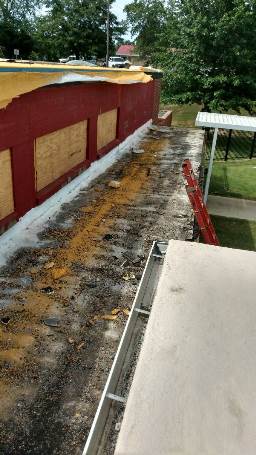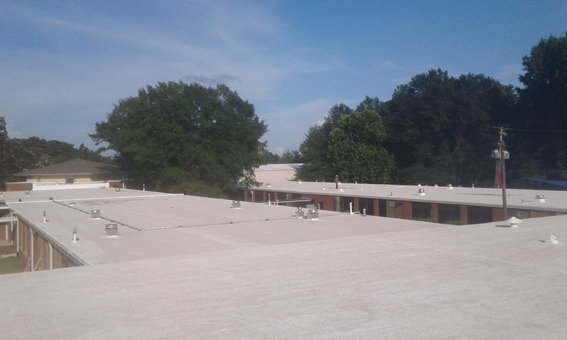When school’s out for summer, that often means that coatings are in! That was true for coatings contracting firm Pro-Seal, LLC, working on five different roofs in Tupelo, Mississippi. The school district’s roofs were metal, wood, built-up, and covered in spray polyurethane foam (SPF), and they were leaking. The crew had little time and lots to cover.
“We had a two-month window to get this done,” said Tony Mastro, sales manager for Pro-Seal. Luckily, the crew was able to get all materials to the site the day before the job started, which meant that they were ready to hit the ground running from day one. Let summer school begin!
A Summertime Blizzard
The first roof was a doozy. To start, the 16,000 square feet (1,486.5 m²) were covered in open-cell foam — a surprise to Pro-Seal. The eight-person crew had intended to scarify and recoat the roof, but because they weren’t sure if the SPF was up to snuff, they decided to take the entire system down to the wooden substrate. “The foam was in such bad shape that it came up very easily,” Mastro explained. They used shovels and scrapers to remove it and 3M dust masks to stay protected. “We’re building a brand. So when an architect and a client see that you’re willing to go the extra mile, in this case when we told them we were going to tear off the roof, they were very excited about that,” Avery said.
The amount of SPF, also called spray foam, that the crew removed from the rooftop meant that the Dumpsters they were using needed to be replaced and monitored daily to avoid what Pro-Seal’s VP Tyler Avery called a “foam blizzard.”
Once the roof was clear, the crew used a 3,300-psi (22.8 MPa) power washer to remove any other debris and let the roof dry overnight.
Leaf blowers played a key role throughout this project, and not just on the spray foam roof. According to Mastro, “this was done in a Mississippi summer in the month of July. You can imagine the relative humidity problems we ran into.” The dew kept them busy blowing from about 7 to 10 a.m. But the summer heat did bring one good thing: no fear of overspray. “The good thing about a Mississippi summer is the air is still,” Mastro explained. “That’s also the bad thing about a Mississippi summer,” he joked, referring to the lack of a cooling breeze.
Progressive Materials’ (PM) 3-pound (1.4 kg) closed-cell spray foam was applied at 1.5‒2 inches (3.8‒5.1 cm) in two passes with Polyurethane Machinery Corp. rigs. The crew tested it for firmness and adhesion and then moved on to two coats of PM low-solids silicone. The first coat was tan and the second coat was white to help ensure the proper coverage and thickness. Each layer was applied with rollers and tanks supplied by Big Rock Supply to a rate of 1.5 gallon (5.7 L) per roofing square (0.09 m²). The coating was topped with Specified Equipment Systems Co. (SESCO) granules broadcast for anti-slip properties.
Anything but Straightforward
 The next two roofs — metal and the ethylene propylene diene monomer (EPDM) — seemed fairly straightforward. They required cleaning, degreasing, power washing, and prepping with PM’s Seam Seal to any penetrations.
The next two roofs — metal and the ethylene propylene diene monomer (EPDM) — seemed fairly straightforward. They required cleaning, degreasing, power washing, and prepping with PM’s Seam Seal to any penetrations.
The metal roof had the only 4:12 pitch, but even with the other flat roofs, fall protection was important throughout this project. The crew wore harnesses 5-feet (1.5 m) from the edge and employed other safety strategies, such as holding daily toolbox talks, taking breaks, and staying hydrated. “We don’t want somebody falling off the roof ’cause they’re dehydrated,” Avery said.
The crew installed the silicone to the metal roof at 2.5 gallons (9.5 L) per roofing square (0.09 m²) with rollers and tanks. Since this was a sloped roof, though, it did not get granules.
The EPDM roof, on the other hand, received 1.5 inches (3.8 cm) of spray foam and the two-coat silicone system. Because the EPDM roof had parapet walls, too, the crew was also sure to tie the foam into that area.
Regardless of which roof the crew was working on, they communicated often with the many other contractors on site. Pro-Seal was constantly moving around the heating, ventilation, and air conditioning (HVAC), flashing, and gutter crews as well as another roofing crew replacing shingles nearby.
“It was a symphony of contractors on that site with a short window to work with,” Mastro said. Pro-Seal met with the other contractors weekly to coordinate. “I know we’re making it sound pretty straightforward, but logically it was far less than straightforward,” Avery said.
Unintentional Green Roof
Next up was the gravel built-up roof (BUR), which took a little more finessing.
First of all, the crew needed to remove the gravel on the BUR. But on top of that, this “very, very small part of the project” had a serious drainage issue, according to Mastro. “There was various plant life on that part of the roof.”
Avery concurred, “It was growing like a garden.” And as he succinctly said, “Any time there’s water sitting on a roof it’s a bad thing.”
Pro-Set wanted to fix the problem with SPF, but the add-on for that portion of the contract hadn’t been accepted by the school. “We decided to do that anyway simply because it would make us a better roof,” Avery explained. And encouraging the water to flow correctly, “in the long-term, it would help our leaking problem and avoid ponding water,” he said. This is what they felt was right for the roof and client. “I would rather eat a couple thousand dollars on a job and make sure it’s right than simply follow the specs 100 percent and leave them with a product that’s not up to our standards,” he continued.
Although the client may not appreciate it right now, Avery is certain that the school will value the properly waterproofed roof in 20 years when it continues to be leak-free.
To that end, the crew sloped the spray foam from 3 inches (7.6 cm) to 1.5 inches (3.8 cm) on the 750-square-foot (69.7 m²) roof. They covered the SPF once again with two coats of the silicone and granules.
On the next roof, the second SPF roof, it wasn’t necessary to take it down to the substrate. They needed to identify areas to cut out and repair, which they accomplished using a FLIR camera. They recoated over the entire roof again with the two-coat silicone system before moving on.
Efficiency and Excellence
With five different roofs and five different roof strategies, the crew finished all 45,000 square feet (4,180.6 m²) in just 40 days. Despite a 10-day rain delay, the crew finished early on all of the rooftop projects. Progressive Materials came on site, took and plugged core and slit samples, and gave the project a 20-year warranty.
“We’ve overwhelmingly had very positive response,” Avery said. “Feedback’s been extremely good.” The architects, general contractor, and members of the school board were all so pleased with the end results that Pro-Seal has been asked to bid on another roof since this project completed.
“Completing ahead of schedule speaks to [the crew’s] efficiency,” Avery said. “And I felt like overall this job was as well managed from a field standpoint as any job we’ve done.”
